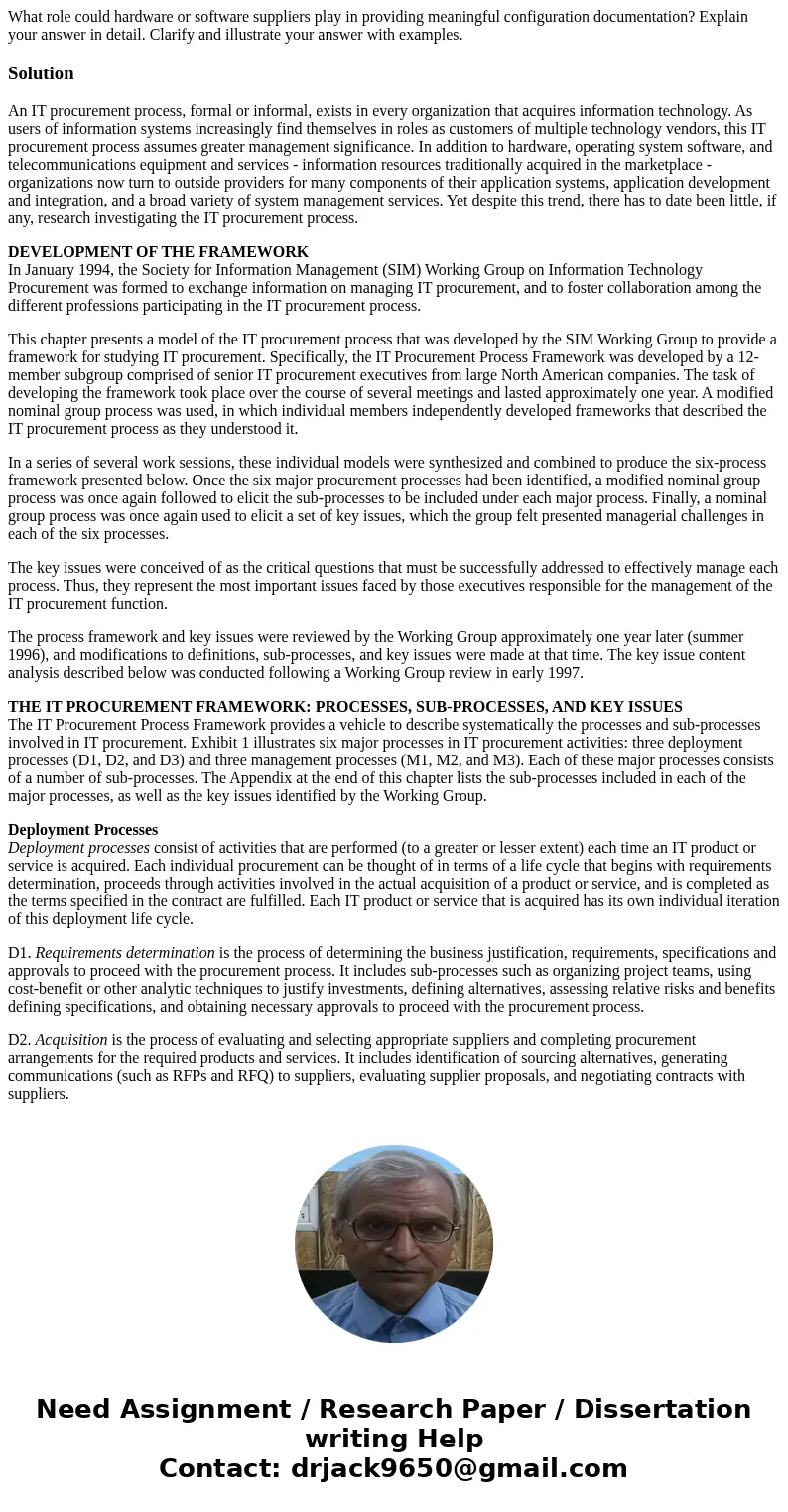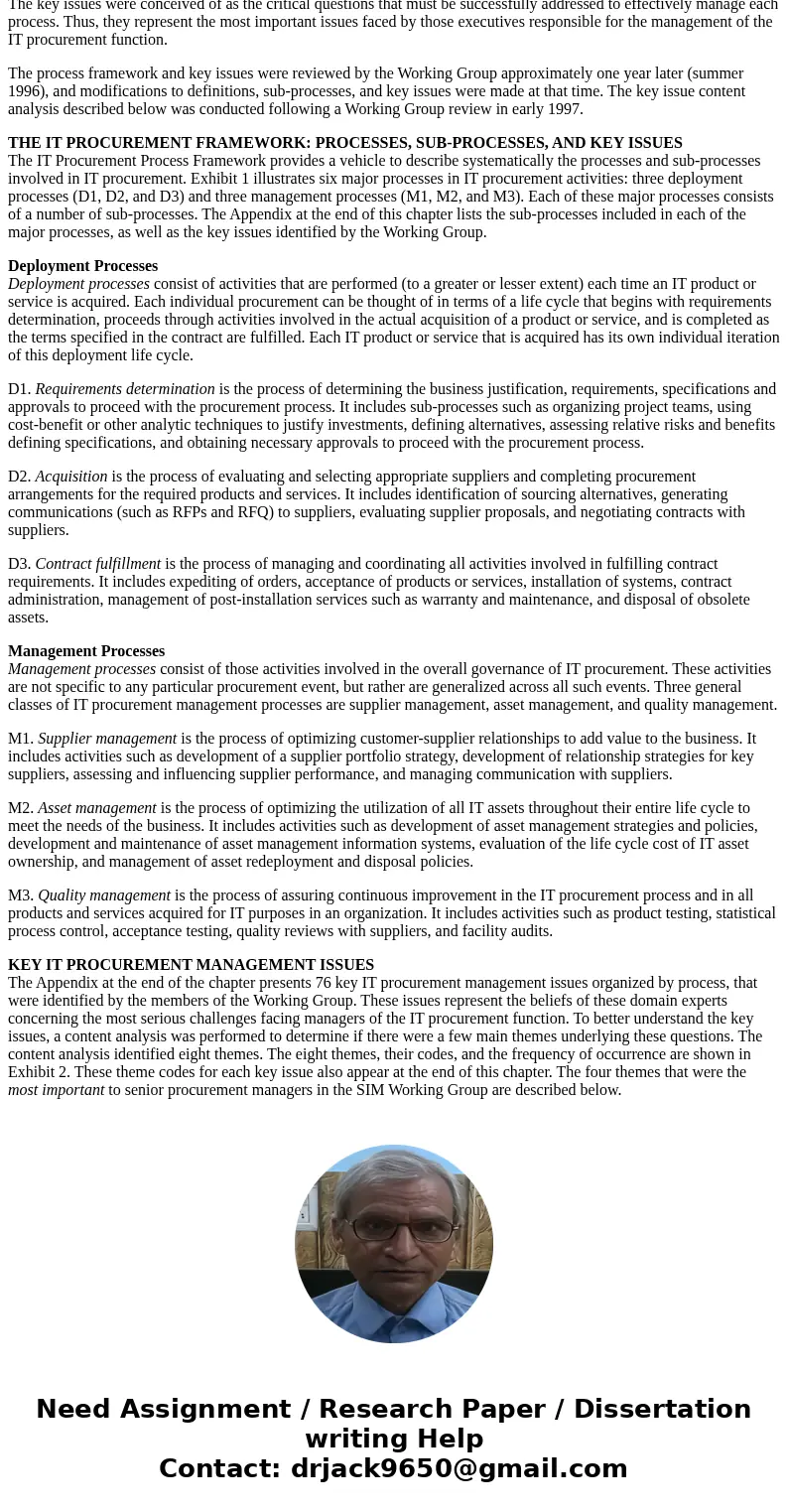What role could hardware or software suppliers play in provi
What role could hardware or software suppliers play in providing meaningful configuration documentation? Explain your answer in detail. Clarify and illustrate your answer with examples.
Solution
An IT procurement process, formal or informal, exists in every organization that acquires information technology. As users of information systems increasingly find themselves in roles as customers of multiple technology vendors, this IT procurement process assumes greater management significance. In addition to hardware, operating system software, and telecommunications equipment and services - information resources traditionally acquired in the marketplace - organizations now turn to outside providers for many components of their application systems, application development and integration, and a broad variety of system management services. Yet despite this trend, there has to date been little, if any, research investigating the IT procurement process.
DEVELOPMENT OF THE FRAMEWORK
In January 1994, the Society for Information Management (SIM) Working Group on Information Technology Procurement was formed to exchange information on managing IT procurement, and to foster collaboration among the different professions participating in the IT procurement process.
This chapter presents a model of the IT procurement process that was developed by the SIM Working Group to provide a framework for studying IT procurement. Specifically, the IT Procurement Process Framework was developed by a 12-member subgroup comprised of senior IT procurement executives from large North American companies. The task of developing the framework took place over the course of several meetings and lasted approximately one year. A modified nominal group process was used, in which individual members independently developed frameworks that described the IT procurement process as they understood it.
In a series of several work sessions, these individual models were synthesized and combined to produce the six-process framework presented below. Once the six major procurement processes had been identified, a modified nominal group process was once again followed to elicit the sub-processes to be included under each major process. Finally, a nominal group process was once again used to elicit a set of key issues, which the group felt presented managerial challenges in each of the six processes.
The key issues were conceived of as the critical questions that must be successfully addressed to effectively manage each process. Thus, they represent the most important issues faced by those executives responsible for the management of the IT procurement function.
The process framework and key issues were reviewed by the Working Group approximately one year later (summer 1996), and modifications to definitions, sub-processes, and key issues were made at that time. The key issue content analysis described below was conducted following a Working Group review in early 1997.
THE IT PROCUREMENT FRAMEWORK: PROCESSES, SUB-PROCESSES, AND KEY ISSUES
The IT Procurement Process Framework provides a vehicle to describe systematically the processes and sub-processes involved in IT procurement. Exhibit 1 illustrates six major processes in IT procurement activities: three deployment processes (D1, D2, and D3) and three management processes (M1, M2, and M3). Each of these major processes consists of a number of sub-processes. The Appendix at the end of this chapter lists the sub-processes included in each of the major processes, as well as the key issues identified by the Working Group.
Deployment Processes
Deployment processes consist of activities that are performed (to a greater or lesser extent) each time an IT product or service is acquired. Each individual procurement can be thought of in terms of a life cycle that begins with requirements determination, proceeds through activities involved in the actual acquisition of a product or service, and is completed as the terms specified in the contract are fulfilled. Each IT product or service that is acquired has its own individual iteration of this deployment life cycle.
D1. Requirements determination is the process of determining the business justification, requirements, specifications and approvals to proceed with the procurement process. It includes sub-processes such as organizing project teams, using cost-benefit or other analytic techniques to justify investments, defining alternatives, assessing relative risks and benefits defining specifications, and obtaining necessary approvals to proceed with the procurement process.
D2. Acquisition is the process of evaluating and selecting appropriate suppliers and completing procurement arrangements for the required products and services. It includes identification of sourcing alternatives, generating communications (such as RFPs and RFQ) to suppliers, evaluating supplier proposals, and negotiating contracts with suppliers.
D3. Contract fulfillment is the process of managing and coordinating all activities involved in fulfilling contract requirements. It includes expediting of orders, acceptance of products or services, installation of systems, contract administration, management of post-installation services such as warranty and maintenance, and disposal of obsolete assets.
Management Processes
Management processes consist of those activities involved in the overall governance of IT procurement. These activities are not specific to any particular procurement event, but rather are generalized across all such events. Three general classes of IT procurement management processes are supplier management, asset management, and quality management.
M1. Supplier management is the process of optimizing customer-supplier relationships to add value to the business. It includes activities such as development of a supplier portfolio strategy, development of relationship strategies for key suppliers, assessing and influencing supplier performance, and managing communication with suppliers.
M2. Asset management is the process of optimizing the utilization of all IT assets throughout their entire life cycle to meet the needs of the business. It includes activities such as development of asset management strategies and policies, development and maintenance of asset management information systems, evaluation of the life cycle cost of IT asset ownership, and management of asset redeployment and disposal policies.
M3. Quality management is the process of assuring continuous improvement in the IT procurement process and in all products and services acquired for IT purposes in an organization. It includes activities such as product testing, statistical process control, acceptance testing, quality reviews with suppliers, and facility audits.
KEY IT PROCUREMENT MANAGEMENT ISSUES
The Appendix at the end of the chapter presents 76 key IT procurement management issues organized by process, that were identified by the members of the Working Group. These issues represent the beliefs of these domain experts concerning the most serious challenges facing managers of the IT procurement function. To better understand the key issues, a content analysis was performed to determine if there were a few main themes underlying these questions. The content analysis identified eight themes. The eight themes, their codes, and the frequency of occurrence are shown in Exhibit 2. These theme codes for each key issue also appear at the end of this chapter. The four themes that were the most important to senior procurement managers in the SIM Working Group are described below.


 Homework Sourse
Homework Sourse